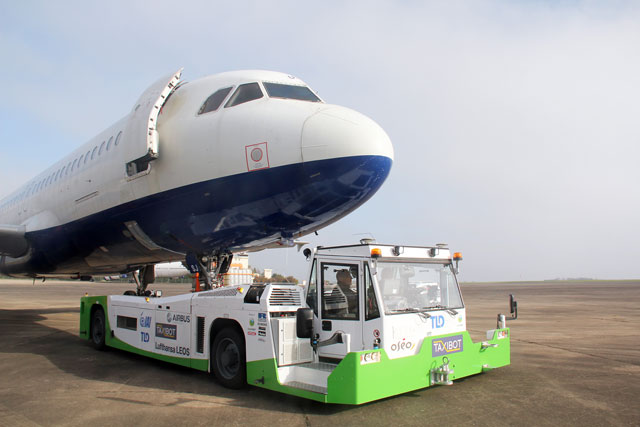Several airlines and ground handling providers have tested the Taxibot pilot-controlled tow-tractor using an ex-British Airways Airbus A320 at France's Châteauroux airport. Israel Aerospace Industries has been developing the semi-robotic vehicle with French ground-support equipment manufacturer TLD Group, Airbus and Lufthansa Engineering and Operational Services. Advanced system tests began in July.
Lufthansa plans to deploy three beta-version Taxibots for its Boeing 737 operations in Frankfurt during a six-month trial from mid-2013, when certification is intended. Regular service will follow in early 2014.
Project director Ran Braier says IAI wanted to gain handling feedback from pilots with no experience of Taxibot, with the tests in France showing better system performance than expected. Data will be used to fine-tune the hybrid-powered vehicle during, for example, software changes. For the trials, IAI used a 1990 A320 (MSN109) and several airlines - including British Airways, Air France, China Eastern, China Southern, FedEx, Lufthansa, United Airlines and WestJet - evaluated the tractor. Ground-handling provider Swissport and France's Aéroports de Paris also participated.
 |
|---|
IAI Crews steered the vehicle using the A320's nose-wheel tiller arm |
Taxibot, operated by a driver, lifts the aircraft's nose wheels for pushback but for taxiing pilots control the tug to avoid unnecessary use of engines. Pilots steer the tractor via the nose-gear tiller in the cockpit, with aircraft wheels resting on a rotating platform, translating nose-gear deflections into directional changes for the tug. Aircraft wheel brakes are used for deceleration. Forward speed is also controlled by braking.
After the tug driver selects pilot-control mode, the tractor starts to move as the flightcrew release the brakes. Braier likens the handling to an automatic car. Maximum speed will be electronically limited depending on the aircraft's position at the airport and, using databases and satellite navigation, the tug could move faster on a straight taxiway while operating slowly on the apron.
The nose-wheel platform also allows some lateral movement to absorb loads and avoid nose-gear damage. Airbus senior vice-president for business development Frédéric Pochet says the system creates no excessive loads and has "absolutely no impact" on nose-gear fatigue life. Pilots reported better handling during runway back-tracking and tight turns than under main engine power, he adds. They were able to make 270˚ turns with the inner main gear "turning on the spot".
The next phase will test Taxibot beyond its design limits, says Braier. Aircraft will be loaded above maximum take-off weight, accelerated beyond the tug's speed limit and stopped with maximum braking. These trials - running December-February - have been scheduled for the end of the testing period. In addition to the eight-wheel narrowbody tractor, IAI is developing a 12-wheel version for widebodies up to the A380. Testing is to begin in 2013, with service entry scheduled for 2016.
IAI is finalising a contract with a launch customer, says Yehoshua Eldar, IAI's corporate vice-president for business development. The unnamed US company leases out tractors to airlines and ground-handling providers, and plans to buy 35 narrowbody and 15 widebody tugs.
Source: Flight International























